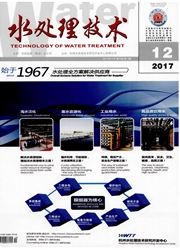

 中文摘要:
中文摘要:
A novel material, alumina supported on carbon nanotubes (Al2O3/CNT), was prepared from carbon nano-tubes and A1(NO3)3. X-ray diffraction (XRD) spectra demonstrate that alumina is amorphous, and scanning electron microscope (SEM) images show that CNT and alumina are homogeneously mixed. Furthermore, the fluoride adsorption behavior on the surface of Al2O3/CNT has been investigated and compared with other adsorbents. The results indicate that Al2O3/CNT has a high adsorption capacity, with a saturation adsorption capacity of 39.4 mg/g. It is also found that the adsorption capacity of Al2O3/CNT is 3.0-4.5 times that of γ-Al2O3 while almost equal to that of IRA-410 polymeric resin at 25°C . The adsorption isotherms of fluoride on Al2O3/CNT fit the Freundlich equation well, and optimal pH ranging from 5.0 to 9.0.
 英文摘要:
英文摘要:
A novel material, alumina supported on carbon nanotubes (Al2O3/CNT), was prepared from carbon nanotubes and Al(NO3)3. X-ray diffraction (XRD) spectra demonstrate that alumina is amorphous, and scanning electron microscope (SEM) images show that CNT and alumina are homogeneously mixed. Furthermore, the fluoride adsorption behavior on the surface of Al2O3/CNT has been investigated and compared with other adsorbents. The results indicate that Al2O3/CNT has a high adsorption capacity, with a saturation adsorption capacity of 39.4 mg/g. It is also found that the adsorption capacity of Al2O2/CNT is 3.0–4.5 times that of γ-Al2O3 while almost equal to that of IRA-410 polymeric resin at 25 °C. The adsorption isotherms of fluoride on Al2O3/CNT fit the Freundlich equation well, and optimal pH ranging from 5.0 to 9.0.
 同期刊论文项目
同期刊论文项目
 同项目期刊论文
同项目期刊论文
 Preparation of alumina supported on carbon nanotubes and its application in fluoride adsorption from
Preparation of alumina supported on carbon nanotubes and its application in fluoride adsorption from 期刊信息
期刊信息
